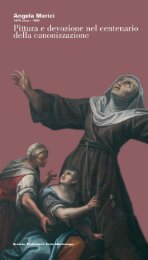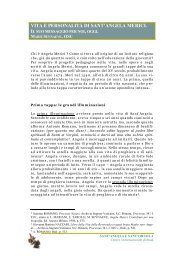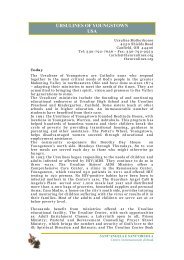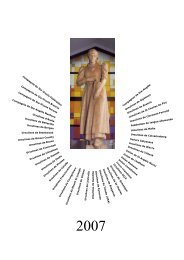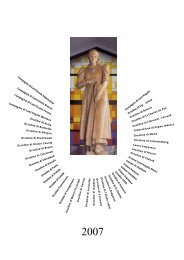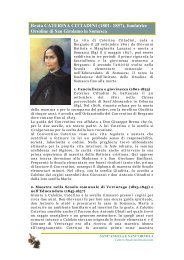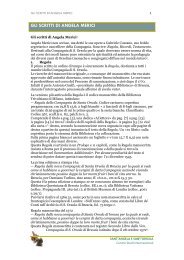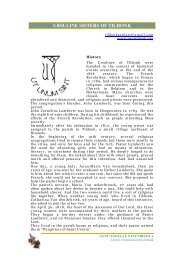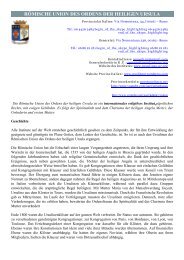URSULINES OF THE CANADIAN UNION - Angelamerici.it
URSULINES OF THE CANADIAN UNION - Angelamerici.it
URSULINES OF THE CANADIAN UNION - Angelamerici.it
You also want an ePaper? Increase the reach of your titles
YUMPU automatically turns print PDFs into web optimized ePapers that Google loves.
<strong>URSULINES</strong> <strong>OF</strong> <strong>THE</strong> <strong>CANADIAN</strong> <strong>UNION</strong><br />
Maison générale des Ursulines<br />
1358 rue Barrin<br />
Québec QC GIS 2G8<br />
Tel: 418- 683-0671 – Fax: 418- 681- 4740<br />
ursule.uc.mg@videotron.ca<br />
www.ursulines-uc.com<br />
Today<br />
The Ursulines of the Canadian Union are the heirs of a centuries-old educational<br />
trad<strong>it</strong>ion. They bear the spir<strong>it</strong>ual genes of Angela Merici and of Marie of the<br />
Incarnation, who were animated by an astonishing apostolic zeal. For man y years,<br />
even in the cloister, they received pupils w<strong>it</strong>hin their walls – just as in Quebec, so<br />
also in Japan and Peru – for primary and secondary education and also for the<br />
form ation of teachers. In Quebec the religious are no long responsible for pri vate<br />
schools, but they continue to support an educational project inspired by Angela<br />
Merici in the spir<strong>it</strong> of Gospel values. There the accent is placed on attention to the<br />
person, the strength of un<strong>it</strong>y in living together, and the power of love as a gift of<br />
God. Ursulines and la y persons are fully engaged, through their presence, in<br />
keeping alive in the schools and colleges that which takes us most to the heart in<br />
our long trad<strong>it</strong>ion.<br />
The religious are also engaged in different areas of pastoral ministry in parish and<br />
hosp<strong>it</strong>al settings and in diocesan services. Some of them lead retreats and general<br />
chapters for diverse commun<strong>it</strong>ies, offer qu<strong>it</strong>e varied spir<strong>it</strong>ual programs nearly<br />
everywhere and for different groups: la<strong>it</strong>y, religious, and diocesan priests. Centers<br />
for spir<strong>it</strong>ual<strong>it</strong> y and retreats conducted by Ursulines in Quebec and in the<br />
Philippines provide different services in the area of spir<strong>it</strong>ual<strong>it</strong>y.<br />
Sisters collaborate in multiple social services on behalf of poor wandering persons,<br />
handicapped people w<strong>it</strong>h problems adapting or learning. Others are in vol ved in the<br />
promotion of women, in welcoming mothers and infants, in helping w<strong>it</strong>h school<br />
homework, and in ecological and environmental struggles.<br />
Com m un<strong>it</strong> y ser vices call for several form s of help in general, provincial, and local<br />
administration, in coordinating the works, and in services such as reception,<br />
k<strong>it</strong>chen, sewing, laundry, building maintenance, accounting, secretarial, archives<br />
and library, l<strong>it</strong>urgy, and caring for the sick.<br />
Let us point out that sisters are also present in the domain of the arts, music, and<br />
painting, in handicrafts, and in l<strong>it</strong>erature through book publication.<br />
History<br />
Three Ursulines arrived in Quebec from Tours, France, on August 1, 1639: Marie of<br />
the Incarnation and two companions, Sister Saint Joseph and Sister Cecilia of the<br />
Holy Cross. One lay foundress, Madame de la Peltrie, financed this project and<br />
accompanied them.<br />
Marie of the Incarnation (legal name Marie Gu yart), had first been the wife of<br />
Claude Martin; the mother of a son, also named Claude; and then had been<br />
widowed when she was nineteen years old. A woman of prayer, of action, and of
<strong>URSULINES</strong> <strong>OF</strong> <strong>THE</strong> CANADAN <strong>UNION</strong><br />
2<br />
apostolic zeal, she responded to the Lord’s call, entrusted her son to responsible<br />
people and to Providence, and entered the Ursulines of Tours at the age of thirtyone.<br />
Angela Merici had recommended to her daughters that they be inspired by “love<br />
of God and zeal for t he sal v a tion of souls.” The y did this in Fra nce b y de votin g<br />
themselves to the education of girls. Marie of the Incarnation, having seen<br />
Canada in a dream and having heard the Lord say to her, “You must go to build<br />
a house for Jesus and Mary,” obtained her superiors’ permission to embark for<br />
Canada. The Ursulines planted themselves in Quebec and there too devoted<br />
themselves to the education of girls, consecrating themselves to this mission by a<br />
fourth vow until 19 2 8. Until her death on April 30, 16 7 2 , Marie Gu y a rt of the<br />
Incarnation spent herself w<strong>it</strong>h great generos<strong>it</strong> y a mong the American Indian<br />
girls and young Frenchwomen. Her abundant correspondence would reveal to<br />
France and to Canada this woman of fa<strong>it</strong>h and of action, an educator and a<br />
mystic.<br />
The monastery of Quebec founded the monastery of Trois-Rivières in 1697 and<br />
one in Rimouski in 1906. Each of the three monasteries ga ve birth to other<br />
monasteries that can be found on the webs<strong>it</strong>e www.ursulines-uc.com. These<br />
monasteries formed the Canadian Union in Quebec in 1953. Its three provinces –<br />
Quebec, Trois-Rivières, and Rimouski – regrouped in 2008 into a single province<br />
called the Province of Quebec.<br />
In Japan, the first Canadian Ursulines arrived at Sendai in 193 6, sent by the<br />
com m un<strong>it</strong> y of the monastery of Quebec. Then, in 1949, the Ursulines of the<br />
monastery in Rimouski founded a mission at Hakodate, which moved to<br />
Hachinohe in 1950. In 1953, at the time of the foundation of the Canadian<br />
Union, the commun<strong>it</strong>ies in Japan formed a single commun<strong>it</strong>y under the name of<br />
the region, becoming a vice-province and then a province in 1975. The Province<br />
of Japa n opened missions in Tok yo in 1 9 7 2 , in Ya gi in 1 9 7 4 (closed in 200 4), a nd<br />
in Shimoda in 1985. In 1989 <strong>it</strong> extended <strong>it</strong>self to the Philippines, specifically to<br />
Mati. A retreat house was also opened in Mati in 1998. A commun<strong>it</strong>y lived in<br />
Mana y from 1998 to 2004, and another opened in Davao in 2010.<br />
In Peru, the Ursulines of Trois-Rivières settled in Auca yo, along the Amazon, in<br />
1961; they founded a mission in Yanashi in 1964, then one in Lima in 1967. The<br />
Ursulines of Peru, in turn, settled in 1968 on the outskirts of Qu<strong>it</strong>o in 1968. They<br />
took charge of the College of our Lady of Fatima, a pre-school, primar y, and<br />
secondar y educational inst<strong>it</strong>ution belonging to the State but directed by the<br />
Ursulines. Peru was recognized as a province in 1975.<br />
In Ha<strong>it</strong>i, one sister has been serving since 2002, especially in the medical sector.<br />
Countries where the Canadian Union is present<br />
Canada, Japan, Peru, Philippines<br />
Links<br />
www.ursulines-uc.com<br />
SANT’ANGELA E SANT’ORSOLA<br />
Centro Internazionale di Studi



